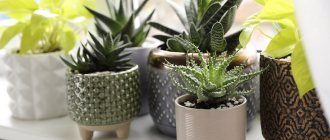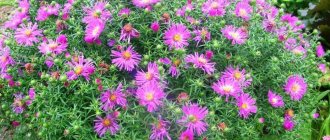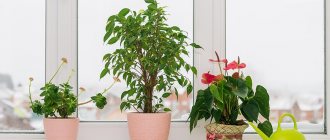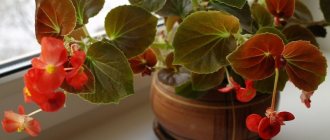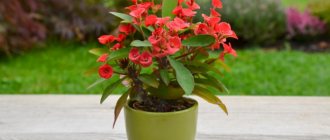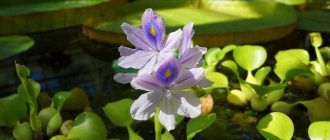Which house flower is the most sun-tolerant?
Cacti and lithops are considered the undoubted leaders in terms of resistance to sunlight. They are able to develop in hot climates, do not suffer from bright light, and calmly tolerate periods of drought. In terms of endurance and resistance to negative external factors, only aloe and “mother-in-law’s tongue” are compared with cacti. These plants are able to calmly tolerate sunlight and heat, sudden drops in temperature, lack of moisture and drafts.
Signs of sun-tolerant flowers:
How to identify sun-tolerant plants?
Of course, not all women understand the numerous abundance of plants and their characteristics. But you can determine their resistance to the sun by eye. All indoor flowers that love the sun,
As a rule, they have fairly dense leaves with a hard surface. Such plants are able to retain moisture well and feel quite comfortable in the sun. A large flower when blooming also indicates sun-loving behavior. A striking example is hyperastrum, clivia. Dieffenbachia also tolerates sun well. In general, you can put the plant on the windowsill for a while. If it feels good and grows well, then the conditions are quite favorable.
Poppy
Silky poppy petals will become a natural decoration for any flower garden. Surprisingly, this delicate flower is not afraid of scorching rays. It can grow in one place for many years without requiring replanting. Poppy is unpretentious and does not require special care. Single large flowers are up to 18 cm in diameter. Moreover, they can be not only bright scarlet. Hobbyists have bred poppy varieties with pink, orange, blue and white petals.
Nasturtium
This plant is great for growing in pots on the outside of the house. Climbing species can be combined with short ones. Magnificent compositions of cherry, golden and orange flowers on graceful cuttings.
Nasturtium has a shallow root system; water it moderately, especially during the flowering period. Too nutritious soil should not be used for planting. Containers must have adequate drainage.
Roses
The royal flowering of these perennial shrubs will not leave any gardener indifferent. This is a very light-loving plant. In the shade it will not show all its wonderful properties. Roses need a sunny, dry area, open to light and warmth. There should be enough space between the bushes, without excessive moisture. Between the roses you can plant geranium, delphinium or clematis.
Physiology and morphology of light-loving plants
Light-loving plants have adapted to sunlight due to their physiology and morphology. They have thickened leaves that are located almost vertical to the sky and change position according to the height of the sun. Basically, their size is small, the shape can be dissected. The surface can be shiny or fluffy.
Heliophytes have superbly formed mechanical tissues with many veins and a huge number of stomata. Their representatives are fruit and ornamental trees and shrubs, luxurious herbs and charming flowers.
Among them are well-known trees:
- pine;
- acacia;
- birch.
Shrubs also like to bask in the sun:
- hawthorn;
- rose hip;
- barberry.
Herbaceous plants reaching for the sun:
- plantain;
- linen;
- St. John's wort.
Flowers love rays of light:
- peonies;
- roses;
- marigold;
- petunia.
Chrysanthemums
Golden buds of chrysanthemums will enliven any, even the most boring landscape. They pair beautifully with asters, sedum and other fall flowers. Nowadays, various colors of this perennial have been developed: white, pink, orange, burgundy. Some species grow into huge bushes - up to 1.5 m. The height of small varieties does not exceed 40 cm. Chrysanthemums also differ in their double size, flower size, and flowering time. In general, this is a very unpretentious perennial that can withstand the vagaries of the weather.
Upright flowers for the sunny side
Planting flowers that form a compact bush or spreading, but do not have flowing shoots, for the sunny side is usually done in balcony boxes or pots. If you place them in hanging pots, the plant will be difficult to see and will lose some of its attractiveness.
Gatsania
African chamomile forms a bush up to 30 cm high. The inflorescence is a basket with a diameter of 5-9 cm with a yellow center and bright petals: yellow, red, orange, white. They can be one color, but more often they are decorated with longitudinal strokes and a contrasting dark spot at the base.
Drought-resistant crop. One bush per season, with satisfactory feeding and timely removal of faded buds, can produce up to 35 flowers.
If you leave several gatsanias in a bright, cool place for the winter, in the spring the bush can be divided into rosettes and planted. They will bloom earlier than those obtained from seeds.
Violet tricolor
You can grow pansies on a sunny balcony. This unpretentious miniature plant is distinguished by dark narrow leaves and an asymmetrical five-petal corolla with a diameter of up to 10 cm.
It seems that the flowers are as unique as snowflakes - even on the same bush their color is at least slightly different. It can vary from white to almost black - deep purple or burgundy, be plain or combined, with spots or streaks of different sizes.
Pansies grown in a two-year culture bloom longer and more abundantly.
Tagetis or marigolds
Varieties of marigolds with a height of 20 to 50-60 cm are excellent flowers for a sunny loggia. They form an erect bush with feathery leaves, hollow stems, simple, semi-double or double inflorescences-baskets and a pronounced cylindrical spathe. Depending on the variety, Tagetis flowers have a diameter of 1-6 cm and are yellow, orange, or brown in color.
When rubbed, all parts of the plant emit a strong, pleasant aroma.
Since the root system of marigolds is taprooted, you need to choose a deep pot or box. To ensure the continuous formation of new buds, the “heads” that have lost their decorative effect are torn off.
Carnation
Most often, low-growing types of carnations are grown in pots. But if space allows, you can choose flowers with a long stem. Several different varieties planted in one container look great.
Carnations require light, so they are placed on the south side of the house. The crop is drought-resistant and does not need to be watered too often. Spraying plants is not recommended. The soil is periodically enriched with mineral fertilizer.
